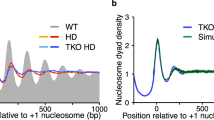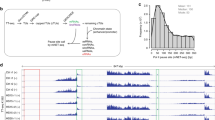Abstract
The ability to identify and purify trans-acting cellular factors that regulate eukaryotic genes is limited by the lack of a practical general assay. Current procedures using crude whole cell or nuclear extracts that restore transcriptional function in vitro or permit reconstruction of native chromatin at control sequences are effective only in select systems. I now present an exonuclease protection assay that is generally applicable for detecting sequence-specific DNA-binding proteins. The assay extends earlier work on the binding to the Drosophila heat-shock gene control element of a protein factor (HAP) present in crude nuclear extracts; the binding was shown by reconstitution of specific exonuclease resistance within a nuclease-hypersensitive site in chromatin1,2. We show here that this same exonuclease resistance can be reconstituted on free linear DNA, despite many nonspecific binding activities present in unfractionated nuclear extracts. We have further applied this assay method to fractionate the protein factor that is bound constitutively to the heat-shock gene TATA box region in native chromatin1. Exonuclease protection offers a sensitive, precise and rapid assay for any sequence-specific DNA-binding protein.
This is a preview of subscription content, access via your institution
Access options
Subscribe to this journal
Receive 51 print issues and online access
$199.00 per year
only $3.90 per issue
Buy this article
- Purchase on Springer Link
- Instant access to full article PDF
Prices may be subject to local taxes which are calculated during checkout
Similar content being viewed by others
References
Wu, C. Nature 309, 229–234 (1984).
Wu, C. Nature 311, 81–84 (1984).
Richardson, C. C. & Kornberg, A. J. biol. Chem. 239, 242–250 (1964).
Richardson, C. C., Lehman, I. R. & Kornberg, A. J. biol. Chem. 239, 251–258 (1964).
Rogers, S. G. & Weiss, B. Meth. Enzym. 65, 201–210 (1980).
Guo, L. H. & Wu, R. Meth. Enzym. 100, 60–96 (1983).
Henikoff, S. Gene 28, 351–359 (1984).
Ptashne, M. et al. Science 194, 156–161 (1976).
Siebenlist, U., Simpson, R. B. & Gilbert, W. Cell 20, 269–281 (1980).
Schreier, P. H., Davies, R. W. & Kotewicz, M. L. FEBS Lett. 109, 159–163 (1980).
Shalloway, D. T., Kleinberger, T. & Livingston, D. M. Cell 20, 411–422 (1980).
Chan, P. T. & Lebowitz, J. Nucleic Acids Res. 11, 1099–1116 (1983).
Vocke, C. & Bastia, D. Cell 35, 495–502 (1983).
Scheidereit, C., Geisse, S., Westphal, H. M. & Beato, M. Nature 304, 749–752 (1983).
Von der Ahe, D. et al. Nature 313, 706–709 (1985).
Prunell, A. & Kornberg, R. D. Cold Spring Harb. Symp. quant. Biol. 42, 103–108 (1977).
Riley, D. & Weintraub, H. Cell 13, 281–293 (1978).
Chao, M. V., Gralla, J. & Martinson, H. G. Biochemistry 18, 1068–1074 (1979).
Igo-Kemenes, T., Omori, A. & Zachau, H. G. Nucleic Acids Res. 8, 5377–5390 (1980).
Horz, W. & Zachau, H. G. J. molec. Biol. 144, 305–327 (1980).
Prunell, A. & Kornberg, R. D. J. molec. Biol. 154, 515–523 (1982).
Strauss, F. & Prunell, A. Nucleic Acids Res. 10, 2275–2293 (1982).
Zhang, X.-Y., Fittler, F. & Horz, W. Nucleic Acids Res. 11, 4287–4306 (1983).
Pelham, H. R. B. Cell 30, 517–528 (1982).
Breathnach, R. & Chambon, P. A Rev. Biochem. 50, 349–383 (1981).
Davidson, B. L., Egly, J. M., Mulvihill, E. R. & Chambon, P. Nature 310, 680–686 (1983).
Costlow, N. A., Simon, J. A. & Lis, J. T. Nature 313, 147–149 (1985).
Author information
Authors and Affiliations
Rights and permissions
About this article
Cite this article
Wu, C. An exonuclease protection assay reveals heat-shock element and TATA box DNA-binding proteins in crude nuclear extracts. Nature 317, 84–87 (1985). https://doi.org/10.1038/317084a0
Received:
Accepted:
Issue Date:
DOI: https://doi.org/10.1038/317084a0
This article is cited by
-
Simultaneous detection of DNA-binding proteins using exo-Taq-based reaction
NanoBiotechnology (2006)
-
Methods for the analysis of DNA-protein interactions
Molecular Biotechnology (1997)
-
Thermal response in murine L929 cells lacking ?B-crystallin expression and ?B-crystallin expressing L929 transfectants
Molecular and Cellular Biochemistry (1996)
-
ATP-dependent nucleosome disruption at a heat-shock promoter mediated by binding of GAGA transcription factor
Nature (1994)
-
Regulation of HSP70 and HSP28 gene expression: absence of compensatory interactions
Molecular and Cellular Biochemistry (1994)
Comments
By submitting a comment you agree to abide by our Terms and Community Guidelines. If you find something abusive or that does not comply with our terms or guidelines please flag it as inappropriate.



